CANADA


CAPITAL: Ottawa.
FLAG: The national flag, adopted in 1964, consists of a red maple leaf on a white field, flanked by a red vertical field on each end.
ANTHEM: Since 1 July 1980, O Canada has been the official anthem.
MONETARY UNIT: The Canadian dollar ( C $) is a paper currency of 100 cents. There are coins of 1, 5, 10, 25, and 50 cents and 1 dollar, and notes of 2, 5, 10, 20, 50, 100, and 1,000 Canadian dollars. Silver coins of 5 and 10 dollars, commemorating the Olympics, were issued during 1973–76. C $1 = US $0.6899 (or US $1 = C $1.45) as of May 2003. US currency is usually accepted, especially in major cities and along the border.
WEIGHTS AND MEASURES: The metric system is the legal standard.
HOLIDAYS: New Year's Day, 1 January; Good Friday; Easter Monday; Victoria Day, the Monday preceding 25 May; Canada Day, 1 July; Labor Day, 1st Monday in September; Thanksgiving Day, 2d Monday in October; Remembrance Day, 11 November; Christmas Day, 25 December; Boxing Day, 26 December. Other holidays are observed in some provinces.
TIME: Newfoundland, 8:30 AM = noon GMT; New Brunswick, Nova Scotia, Prince Edward Island, and Québec, 8 AM = noon GMT; Ontario east of 90° and western Québec, 7 AM = noon GMT; western Ontario and Manitoba, 6 AM = noon GMT; Alberta and Saskatchewan, 5 AM = noon GMT; British Columbia and Yukon Territory, 4 AM = noon GMT.
1 LOCATION AND SIZE
Canada consists of all of the North American continent north of the United States, except Alaska and the small French islands of St. Pierre and Miquelon. Its total land area of 3,855,175 square miles (9,984,670 square kilometers) makes it slightly larger than China and the United States. The country's total boundary length is 131,099 miles (210,973 kilometers). Canada's capital city, Ottawa, is located in the southeastern part of the country.
2 TOPOGRAPHY
Canada's topography is dominated by the Canadian Shield, an area of Precambrian rocks surrounding the Hudson Bay and covering half the country. East of the Shield is the Maritime area, separated from the rest of Canada by low mountain ranges, and including the island of Newfoundland and Prince Edward Island. South and southeast of the Shield are the Great Lakes–St. Lawrence lowlands, a fertile plain in the triangle bounded by the St. Lawrence River, Lake Ontario, and Georgian Bay.
West of the Shield are the farmlands and ranching areas of the great central plains. Toward the north of this section is a series of rich mining areas, and still farther north is the Mackenzie lowland, traversed (crossed) by many lakes and rivers. The westernmost region of Canada, extending from western Alberta to the Pacific Ocean, includes the Rocky Mountains, a plateau region, the coastal mountain range, and an inner sea passage separating the outer island groups from the fjord-lined (narrow sea inlet) coast. Mt. Logan, the highest peak in Canada, in the St. Elias Range near the Alaska border, is 19,551 feet (5,959 meters) high. The Arctic islands constitute a large group extending north of the Canadian mainland to within 550 miles (885 kilometers) of the North Pole. They vary greatly in size and topography, with mountains, plateaus, fjords, and low coastal plains.
The Nelson-Saskatchewan, Churchill, Severn, and Albany rivers flow into Hudson Bay. The 2,635-miles (4,241-kilometers) Mackenzie River drains an area of almost 1 million square miles (2.6 million square kilometers) into the Arctic Ocean. The Great Lakes drain into the broad St. Lawrence River, which flows into the Gulf of St. Lawrence.
3 CLIMATE
Most of northern Canada has subarctic or arctic climates, with long cold winters lasting 8 to 11 months, short sunny summers, and little precipitation. In contrast, the populated south has a variety of climates.
Canada Population Profile
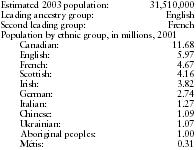
| Estimated 2003 population: | 31,510,000 |
| Leading ancestry group: | English |
| Second leading group: | French |
| Population by ethnic group, in millions, 2001 | |
| Canadian: | 11.68 |
| English: | 5.97 |
| French: | 4.67 |
| Scottish: | 4.16 |
| Irish: | 3.82 |
| German: | 2.74 |
| Italian: | 1.27 |
| Chinese: | 1.09 |
| Ukrainian: | 1.07 |
| Aboriginal peoples: | 1.00 |
| Métis: | 0.31 |
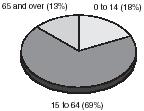
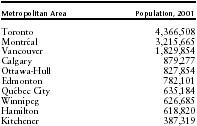
| Metropolitan Area | Population, 2001 |
| Toronto | 4,366,508 |
| Montréal | 3,215,665 |
| Vancouver | 1,829,854 |
| Calgary | 879,277 |
| Ottawa-Hull | 827,854 |
| Edmonton | 782,101 |
| Québec City | 635,184 |
| Winnipeg | 626,685 |
| Hamilton | 618,820 |
| Kitchener | 387,319 |
Cool summers and mild winters prevail along the Pacific coast of British Columbia. Mean temperatures range from about 4° C (39° F ) in January to 16° C (61° F ) in July, the smallest range in the country. In Ontario and Québec, especially near the Great Lakes and along the St. Lawrence River, the climate is less severe than in western Canada.
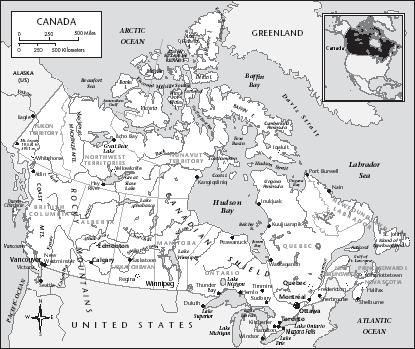
The northwest and the prairies are the driest areas. The windward mountain slopes are exceptionally wet; the protected slopes are very dry. Thus, the west coast gets about 60–120 inches (150–300 centimeters) of rain annually; the central prairie area, less than 20 inches (50 centimeters); the flat area east of Winnipeg, 20–40 inches (50–100 centimeters); and the Maritime provinces, 45–60 inches (115–150 centimeters). The annual average number of days of precipitation ranges from 252 along coastal British Columbia, to 100 in the interior of the province.
4 PLANTS AND ANIMALS
A great range of plant and animal life characterizes the vast area of Canada, with its varied geographic and climatic zones. The flora of the Great Lakes–St. Lawrence region include white pine, sugar and red maples, and beech trees. Coniferous trees (evergreens) abound in the Maritime region, and black spruce in the eastern Laurentian zone.
From the prairie grassland to the Arctic tundra there are aspen, bur oak, cottonwood, and other deciduous (those that shed leaves seasonally) trees. Conifers dominate the northern section. Many types of grasses grow on the interior plains. The wet area along the west coast is famous for its tall, hard conifers. In the Rocky Mountain area are alpine fir, Engelmann spruce, and lodgepole pine. The great Arctic region is covered with low-growing grasses, mosses, and bushes.
Animals range from deer, black bear, and opossum in the Great Lakes–St. Lawrence region to moose, caribou, and timber wolf in the northern forests, and grizzly bear, mountain goat, and moose in the Rocky Mountain area. Birds include the robin, wood thrush, woodpecker, northern Pigmy-owl, band-tailed pigeon, snowy owl, ptarmigan, and arctic tern. Walrus, seals, and whales inhabit Canada's coastal waters.
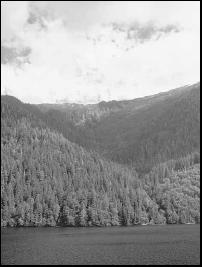
5 ENVIRONMENTAL PROTECTION
Among Canada's most pressing environmental problems has been acid rain, which poses a threat to natural resources in about 1 million square miles (2.6 million square kilometers) of eastern Canada. As of the mid-1990s, acid rain had affected 150,000 lakes in total throughout Canada. About half the acid rain comes from emissions from Canadian smokestacks, but Canada has blamed United States industry for 75 percent of Ontario pollution.
Canada's rivers have been polluted by agriculture and industry. As of the mid-1990s, 50 percent of Canada's coastal shellfish areas were closed because of dangerous pollutant levels.
Canada has more than 90 bird sanctuaries and 44 National Wildlife Areas, including reserves in the western Arctic to protect waterfowl nesting grounds. The annual Newfoundland seal hunt, producing seals for pelts and meat, drew the anger of environmentalists, chiefly because of the practice of clubbing baby seals to death (adult seals are shot). In 1987, Canada banned the offshore hunting of baby seals, as well as blueback hooded seals.
Endangered species in Canada include the Vancouver marmot, eastern puma, wood bison, sea otter, right whale, St. Lawrence beluga, spotted owl, leatherback turtle, whooping crane, and the southern bald eagle. As of 2001, of a total of 193 mammals, 7 were endangered. Five bird species are also endangered. Out of a total of 3,270-plus plant species nationwide, 40 are endangered.
6 POPULATION
The total estimated population in 2003 was 31,510,000. A population of 34.13 million is forecasted for 2015. About 19 percent of the population is under 15.
The average population density in 2002 was 8 per square mile (3 per square kilometer). The population is unevenly distributed, ranging from 0.045 per square mile (0.02 per square kilometer) in the Northwest Territories, to 59 per square mile (22.8 per square kilometer) on Prince Edward Island. Nearly 85 percent of the people live within 93 miles (150 kilometers) of the United States boundary. The population movement has long been from rural to urban areas.
The Toronto metropolitan area had an estimated population of 4.66 million in 2001; Montréal, 3.4 million. Other large metropolitan areas are Vancouver, 1.98 million; Ottawa-Hull (Ottawa is the federal capital), 1.09 million; Edmonton, 913,000; Calgary, 888,000; Winnipeg, 652,354; Québec City, 645,550; Hamilton, 599,760; and London, 381,522.
7 ETHNIC GROUPS
More than 80 percent of the population is Canadian-born. Persons wholly or partially of British origin (including Irish) make up about 28 percent of the total population; those of total or partial French origin (centered mainly in Québec, where they constitute 80 percent of the population), 23 percent. Other European groups account for 15 percent of the total populace, including Germans, Italians, Ukrainians, Dutch, and Poles. About 26 percent of the total population claims multiple ethnic origin. Others, mostly Asian, African, and Arabs, make up about 6 percent of the population.
Amerindians constitute about 2 percent of the population. These Indians were classified into 10 major groups by language. The Métis, of mixed European and Indian descent, were recognized as an Aboriginal people in 1982.
Most of the Inuit (Eskimos) live in Nunavut, with smaller numbers in northern Québec, northern Newfoundland (Labrador), and the northeastern part of Northwest Territories.
8 LANGUAGES
English and French are the official languages of Canada and have equal status and equal rights and privileges as to their use in all governmental institutions. The federal constitution also gives English and French speakers the right to publicly funded education in their own language at the primary and secondary levels, wherever the number of children justifies it.
The constitution provides for the use of both English and French in the legislature and courts of Québec, New Brunswick, and Manitoba. Although there are no similar constitutional rights in Ontario and Saskatchewan, these provinces have made English and French the official languages of the courts. In 1984, the Northwest Territories Council adopted an ordinance providing for the use of aboriginal languages and establishing English and French as official languages.
Although Canada is frequently referred to as a bilingual country, only a minority are able to speak both English and French. In Québec, more than 80 percent of the people speak French as a native language; in the other provinces, most of the people speak only English.
Some 60 percent of Canadians report that their only mother tongue is English. Only about 24 percent say that it is French. About 15 percent report a single mother tongue other than English or French. Italian, German, Chinese, Ukranian, Portuguese, and Polish are spoken by small numbers of people. There are at least 58 different Indian languages and dialects. Cree is the most common Indian language.
9 RELIGIONS
The principal religious denominations in Canada and their percentage of the total population in 2001 were the Roman Catholic Church (43.2 percent), United Church of Canada (9.6 percent), Anglican Church of Canada (6.9 percent), Baptists (2.5 percent), Lutherans (2 percent), and Presbyterian Church of Canada (1.4 percent). Also represented are Greek Orthodox, Russian Orthodox, Greek Catholic, Mennonite, Pentecostal, and other groups. Members of other religions include Muslims (2 percent), Jews (1.1 percent), Buddhists (1 percent), Hindus (1 percent), and Sikhs (0.9 percent). Approximately 16.2 percent of the population has no religious affiliation.
10 TRANSPORTATION
In spite of the rapid growth of road, air, and pipeline services since 1945, railways are still important because they can supply all-weather transportation in large volume over continental distances. There were 22,441 miles (36,114 kilometers) of standard gauge railways in 2001. About 90 percent of the railway facilities are operated by two great continental systems. They are the government-owned Canadian National Railways (CNR), which was privatized in 1995, and the privately owned Canadian Pacific Ltd. (CP). CNR and CP also maintain steamships and ferries, nationwide telegraph services, highway transport services, and hotel chains.
Because of difficult winter weather conditions, road maintenance is a continual and expensive task. There are about 560,442 miles (901,902 kilometers) of roads, including 197,835 miles (318,371 kilometers) of paved highway. Canada ranks next to the United States in per capita use of motor transport, with one passenger car for every two persons. In 2000, motor vehicles in use totaled 18,449,900, including 14,147,300 passenger cars and 4,302,600 trucks, buses, and taxis.
Canada makes heavy use of water transport in domestic as well as foreign commerce. Canada has 3,000 kilometers (1,864 miles) of waterways, including the Saint Lawrence Seaway. The major part of Canada's merchant fleet consists of tankers. Montréal is Canada's largest port and the world's largest grain port. Other well-equipped ports are Toronto, Hamilton, Port Arthur, and Fort William on the Great Lakes, and Vancouver on the Pacific Coast.
The St. Lawrence Seaway and Power Project, constructed jointly by Canada and the United States, provides a 27-foot-deep (8-meter) navigation channel from Montréal to Lake Superior. The Athabasca and Slave Rivers and the Mackenzie, into which they flow, provide an inland, seasonal water transportation system from Alberta to the Arctic Ocean. The Yukon River is also navigable.
International air service is provided by government-owned Air Canada and Canadian Airlines. Regional service is provided
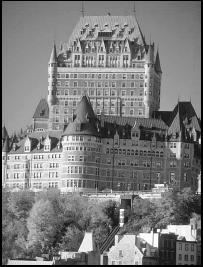
11 HISTORY
The first inhabitants of what is now Canada were the ancient ancestors of the Inuit, who probably entered the region between 15,000 and 10,000 BC . Although most Inuit lived near the coast, some followed the caribou herds to the interior and developed a culture based on hunting and inland fishing.
The first recorded arrival of Europeans was in 1497 by the Italian-born John Cabot, who led an English expedition to the shore of a "new found land" (Newfoundland) and claimed the area in the name of Henry VII. In 1534, the French, under Jacques Cartier, claimed the Gaspé Peninsula and discovered the St. Lawrence River the following year.
By 1604, the first permanent French colony, Port Royal (now Annapolis Royal, Nova Scotia), had been founded. Four years later, Samuel de Champlain established the town of Québec. With the discovery of the Great Lakes, missionaries and fur traders arrived, and an enormous French territory was established. Between 1608 and 1756, about 10,000 French settlers arrived in Canada. In 1663, New France became a royal province of the French crown.
The movement of exploration, discovery, commercial exploitation, and missionary activity which had begun with the coming of Champlain, was extended by such men as Jacques Marquette, reaching its climax in the last three decades of the 17th century. At that time, French trade and empire stretched north to the shores of Hudson Bay, west to the head of the Great Lakes, and south to the Gulf of Mexico. Meanwhile, a British enterprise, the Hudson's Bay Company, founded in 1670, began to compete for the fur trade.
The European wars between England and France were paralleled in North America by a series of French and Indian wars. The imperial contest ended after British troops, commanded by James Wolfe, defeated Marquis Louis Joseph de Montcalm on the Plains of Abraham, bringing the fall of Québec in 1759. The French army surrendered at Montréal in 1760, and the Treaty of Paris in 1763 established British rule over what had been New France.
The Québec Act of 1774 instituted the separateness of French-speaking Canada that has become a distinctive feature of the country. It also secured the loyalty of the French clergy and aristocracy to the British crown during the American Revolution. Some 40,000 Loyalists from the colonies fled in revolt northward to eastern Canada.
Alexander Mackenzie reached the Arctic Ocean in 1789 and journeyed to the Pacific Ocean in 1793. British mariners secured for Britain a firm hold on what is now British Columbia. The War of 1812, in which United States forces attempting to invade Canada were repulsed by Canadian and British soldiers, did not change either the general situation or the United States-Canadian boundary. In 1846, the United States–Canadian border in the west was resolved at 49° N , and since then, except for minor disputes, the long border has been a line of peace.
The movement for Canadian confederation—political union of the colonies—was spurred in the 1860s by the need for common defense and the desire for a common government to sponsor railroads and other transportation. In 1864 Upper Canada (present-day Ontario) and Lower Canada (Québec) were united under a common dominion (authority) government.
In 1867, the British North America Act created a larger dominion that was a confederation of Nova Scotia, New Brunswick, and the two provinces of Canada. Since the name Canada was chosen for the entire country, Lower Canada and Upper Canada assumed their present-day names of Québec and Ontario.
In 1870, the province of Manitoba was established and admitted to the confederation, and the Northwest Territories were transferred to the federal government. British Columbia, on the Pacific shore, joined the confederation in 1871, and Prince Edward Island joined in 1873.
By the turn of the century, immigration to the western provinces had risen swiftly, and the prairie agricultural empire bloomed. Large-scale development of mines and of hydroelectric resources helped spur the growth of industry and urbanization. Alberta and Saskatchewan were made provinces in 1905.
In 1921, Manitoba, Ontario, and Québec were greatly enlarged to take in all territory west of Hudson Bay and south of 60° N and all territory east of Ungava Bay. In February 1931, Norway formally recognized the Canadian title to the Sverdrup group of Arctic islands (now the Queen Elizabeth Islands). Newfoundland remained apart from the confederation until after World War II (1939–45); it became Canada's tenth province in March 1949.
More than 600,000 Canadians served with the Allies in World War I (1914–18), and over 68,000 were killed. The war contributions of Canada and other dominions helped bring about the declaration of equality of the members of the British Commonwealth in the Statute of Westminster of 1931. After the war, the development of air transportation and roads helped weld Canada together, and the nation had sufficient strength to withstand the depression that began in 1929, and the droughts that brought ruin to wheat fields.
Canada was vitally important again in World War II. More than one million Canadians took part in the Allied war effort, and over 32,000 were killed. The nation emerged from the war with enhanced prestige, actively concerned with world affairs and fully committed to the Atlantic alliance.
Domestically, a far-reaching postwar development was the resurgence in the 1960s of French Canadian separatism. Although administrative reforms—including the establishment of French as Québec's official language in 1974—helped meet the demands of cultural nationalists, separatism continued to be an important force in Canadian politics. In the 1976 provincial elections, the separatist Parti Québécois came to power in Québec, and its leader, Premier René Lévesque, proposed that Québec become politically independent from Canada. However, his proposal was defeated, 59.5 percent to 40.5 percent, in a 1980 referendum.
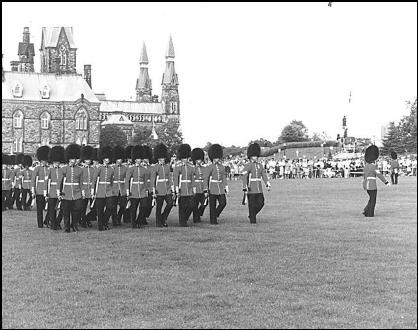
Meanwhile, other provinces had their own grievances, especially over oil revenues. The failure of Newfoundland and the federal government to agree on development and revenue sharing stalled the exploitation of the vast Hibernia offshore oil and gas field in the early 1980s.
In the 1980s, Liberal Prime Minister Pierre Elliott Trudeau worked for "patriation" of the constitution (revoking the British North America Act so that Canada could reclaim authority over its own constitution from the United Kingdom). The Constitution Act, passed in December 1981 and proclaimed by Queen Elizabeth II on 17 April 1982, thus replaced the British North America Act as the basic document of Canadian government. However, Québec, New Brunswick, and Manitoba failed to ratify it due to inter-provincial tensions and other problems.
Canada joined with the United States and Mexico to negotiate the North American Free Trade Agreement (NAFTA), which was built upon the United States–Canada Free Trade Agreement (FTA). The three nations came to an agreement in August 1992 and signed the text on 17 December 1992. NAFTA, which seeks to create a single common market of 370 million consumers, was implemented in 1994.
Like the French Canadians of Québec, Canada's native peoples have challenged the federal government on issues of identity and autonomy. In 1992, the Inuits approved an agreement by which the country's Northwest Territories would be divided in two. The eastern part would comprise the semi-autonomous Nunavut territory, which would serve as an Inuit homeland. In 1999, the Nunavut territory was officially founded as a homeland for the Inuit. Nunavut is larger than Western Europe.
On 30 October 1995, Québec held a referendum on secession from Canada. The measure was defeated by the narrowest of margins—a majority of less than 1 percent. The province remains deeply divided over the secession issue.
In 2000, Canada's conservatives voted to create the new Alliance Party in an attempt to unite the western-based right-wing Reform Party with the Progressive Conservatives. This was largely done to prevent regional fragmentation of the conservatives.
Same-sex marriages were legalized in Ontario and in British Columbia in 2003. As of 2004, a federal bill to formally legalize same-sex marriages in Canada was under consideration.
Severe acute respiratory syndrome (SARS) plagued Canada in 2003, as it did countries in Asia that year. SARS was first recognized in Toronto in a woman who had returned from Hong Kong in February 2003. Transmission to others led to an outbreak among 257 people in the Toronto area. The World Health Organization (WHO) issued a travel advisory to Toronto on 22 April. The advisory was lifted on 30 April 2003.
On 14 August 2003, a massive blackout struck Ontario and parts of the Midwest and Northeast in the US. Power was severed for 50 million people from Detroit to Toronto and Ottawa to east of New York. Ten million people in Ontario were affected. In Ottawa, looting and two deaths resulted from the crisis. It was estimated that the blackout would cost Ontario C $550 million.
On 20 May 2003, it was disclosed that a cow in Alberta had bovine spongiform encephalopathy, or "mad cow disease." The US and other Canadian beef importers placed an immediate ban on exports of Canadian beef. The ban lasted until September 2003. Herd sizes in all Canadian provinces rose after the ban ended. By January 2004, herd sizes in Alberta had risen by 6.9 percent.
12 PROVINCIAL GOVERNMENT
Canada is a federation of ten provinces and three northern territories (including the Nunavut territory formed in 1999). In 1982, the British North America Act of 1867—which effectively served, together with a series of subsequent British statutes, as Canada's constitution—was superseded by the Constitution Act (or Canada Act). Its principal innovations are the Charter of Rights and Freedoms and the provision for amendment.
Under the Constitution Act, the British sovereign remains sovereign of Canada and head of state. For the most part, the personal participation of Queen Elizabeth II in the function of the crown for Canada is reserved for such occasions as a royal visit. The queen's personal representative in the federal government is the governor-general. The governor-general is appointed by the crown on the advice of the prime minister of Canada.
The federal Parliament is made up of the House of Commons and the Senate. A new House of Commons, with 301 members as of 1999, is elected at least once every five years. The leader of the party that wins the largest number of seats in a newly elected House of Commons becomes prime minister and is asked to form the government. The governor-in-council (cabinet) is chosen by the prime minister.
The 105 members of the Senate, or upper house, are appointed for life, or until age 75. The senators are appointed by the governor-general on the nomination of the prime minister, with equality of representation for regional divisions. In October 1992, Canadian voters declined a constitutional amendment that would have made the Senate an elected body.
13 POLITICAL PARTIES
Throughout most of the 20th century, national unity was the primary aim of every Canadian government: Leaders of both the English-speaking majority and the French-speaking minority cooperated to develop a united Canada to which differences arising from national origin were subordinate (of an inferior rank). Canadian nationalism was fueled partially by reaction against being too closely identified with either the United Kingdom or the United States. In the 1970s, this unity was challenged by a growing demand for French Canadian autonomy (independence).
The Liberal Party (LP), which held office from 1935 to 1957, again (except for part of 1979) from 1968 to 1984, and again from 1993, traditionally emphasizes trade and cultural relationships with the United States. Its principal rival, the Progressive Conservative Party (PC), which held power from 1957 to 1968, from May to December 1979, and from 1984 to 1993, stresses Canada's relationships with the United Kingdom. In economic policy, the Liberals generally champion free trade, while the Conservatives favor a degree of government protection.
The New Democratic Party (NDP) is a labor-oriented party formed in 1961 by the merger of The Cooperative Commonwealth Federation (CCF) and the Canadian Labour Congress.
The right-wing Reform Party was formed in 1998. It won support in the western provinces. The Canadian Alliance was formed in January 2000. It was formed to unite conservatives from both the Reform Party and the Progressive Conservatives.
Brian Mulroney became prime minister following a landslide PC victory in the September 1984 elections. In 1993, the PC fell from power, primarily due to one of the worst Canadian recessions in nearly 60 years and the failure of the PC government to implement constitutional reforms.
Mulroney resigned and was succeeded by Kim Campbell. Liberals soundly defeated the PC in the October 1993 election. The Liberal party named Jean Chrétien as the prime minister. Chrétien and the Liberal Party won a second victory in June 1997.
Elections for the House of Commons were held in November 2000. The Liberal Party won 41 percent of the vote, the Canadian Alliance won 26 percent, and the Progressive Conservatives won 12 percent. Jean Chrétien stepped down as prime minister and entered retirement in December 2003. Paul Martin was named leader of the Liberals, and became prime minister.
14 LOCAL GOVERNMENT
Each province is divided into municipalities, the number and structure of which vary from province to province. In Prince Edward Island, Nova Scotia, New Brunswick, Ontario, and Québec the first order of municipalities consists of counties, which are further subdivided into cities, towns, villages, and townships, although there are minor variations. In Newfoundland and the four western provinces there are no counties; municipalities are either rural or urban, the latter being made up of cities, towns, and villages, but again with minor variations. Municipalities are usually administered by an elected council headed by a mayor, overseer, reeve, or warden. Local governments are incorporated by the provinces, and their powers and responsibilities are specifically set forth in provincial laws.
15 JUDICIAL SYSTEM
Civil and criminal courts exist on county, district, and superior levels. The Supreme Court in Ottawa has appeals, civil, and criminal jurisdiction throughout Canada; its chief justice and eight associate justices are appointed by the governor-general. The Federal Court of Canada (formerly the Exchequer Court) hears cases having to do with taxation, claims involving the federal government, copyrights, and admiralty (maritime) law. The death penalty in Canada was abolished in 1976; that decision was upheld in a vote by the House of Commons in June 1987. Canada accepts compulsory jurisdiction of the International Court of Justice (World Court) with reservations.
16 MIGRATION
In the year ended 30 June 2000, total immigration was 205,469. Of these, immigrants from Asia numbered 134,532; Europe accounted for 50,050; Africa, 19,033; the Caribbean, 19,028; the United States, 6,565; and South America, 11,327. Emigration is mainly to the United States.
Canada is a major source of asylum for persecuted refugees. In 2001, 40,040 people sought asylum in Canada as refugees. These people came primarily from Hungary, Pakistan, Sri Lanka, Zimbabwe, and China. There were 30,030 refugees in the country in 2001.
Interprovincial migration is generally from east to west. During 1990–91 British Columbia gained 37,620 more people from other provinces than it lost, and Alberta 7,502, while Ontario lost 22,301 more than it gained, as did Saskatchewan (9,941) and Québec (7,690). In 2001, the net migration rate for Canada was 4.8 migrants per 1,000 people.
17 ECONOMY
The Canadian economy is the seventh largest among the western industrialized nations. The postwar period has seen a steady shift from the production of goods toward increased emphasis on services. Although no longer the foremost sector of the economy, agriculture is of major importance to the economy. Canada accounts for approximately 20 percent of the world's wheat trade. Canada is also the world's leading producer of newsprint and ranks among the leaders in other forestry products.
Differences in prosperity among the provinces increased during the 1980s, with the central provinces relatively robust, the western provinces suffering declines in growth because of lower prices for oil and other natural resources, and the Atlantic provinces depressed. By the second quarter of 1990, the economy had begun to decline, affected by a recession and the central bank's monetary policy. Recovery began in the second half of 1991, although the early 1990s were marked by continuing unemployment.
NAFTA (the North American Free Trade Agreement between Canada, Mexico, and the US) came into existence in 1994. Since then there has been a dramatic increase in trade and economic integration with the US especially. Because the US and Canadian economies are closely linked, the US recession in 2001 and subsequent economic downturn had a negative effect on the Canadian economy. Unemployment rose, and the manufacturing and natural resource sectors shrank. But Canada's vast natural resources and skilled labor force create sound economic prospects for the future. An important strength of the economy is Canada's trade surplus with other nations.
18 INCOME
In 2002, Canada's gross domestic product (GDP) was estimated at US $923 billion. This amounted to US $29,400 per person. The average inflation rate was 2.2 percent in 2002. The country's household consumption per person in 2001 was US $12,866.
19 INDUSTRY
The leading industrial areas are foods and beverages, transport equipment, petroleum and coal products, paper and paper products, primary metals, chemicals, fabricated metals, electrical products, and wood products. Industry accounted for 27 percent of GDP in 2001.
Of the total manufacturing output, about half is concentrated in Ontario, which not only is the center of Canadian industry but also has the greatest industrial diversification. Some important industries operate there exclusively. Québec ranks second in manufacturing production, accounting for more than 25 percent of the value of Canadian manufactured goods. British Columbia ranks third.
20 LABOR
In 2001, the labor force numbered 16.4 million workers. About 74 percent of those workers work in service industries. In addition, 15 percent worked in manufacturing, 5 percent in construction, 3 percent in agriculture, and the remaining 3 percent in other occupations. In 2002, unemployment stood at 7.6 percent.
Cold weather and consumer buying habits cause some regular seasonal unemployment, but new techniques and materials are making winter construction work more possible, and both government and many industrial firms plan as much work as possible during the winter months.
Labor organizations active in Canada report total membership of four million, or about 29 percent of all civilian workers. Federal and provincial laws set minimum standards for hours of work, wages, and other conditions of employment. Safety and health regulations and workers' disability compensation have been established by federal, provincial, and municipal legislation.
21 AGRICULTURE
Until the beginning of the 1900s, agriculture was the most common Canadian occupation. Since then, however, the farm population has been shrinking. Even in Saskatchewan, the province with the highest proportion of farmers, farm families account for no more than 25 percent of the total population. For Canada as a whole, agriculture engaged only 2.4 percent of the economically active population in 1999.
However, Canada is still one of the major food-exporting countries of the world. Farm production continues to increase, as do the size of holdings, crop quantity, quality and variety, and cash income. In 2001, farm cash receipts for crops totaled C $13.6 billion.
More than 90 percent of Canada's cultivated area is in the three prairie provinces of Alberta, Saskatchewan, and Manitoba. The trend is toward fewer and larger farms, increased use of machinery, and more specialization.
The estimated output of principal field crops in 1999 was wheat, 26.8 million tons; barley, 13.2 million tons; corn, 9.1 million; rapeseed (canola), 8.8 million tons; and oats, 3.6 million tons.
In 2001, Canada exported 21.5 million tons of grain. This placed Canada third behind the US and France in grain exports.
22 DOMESTICATED ANIMALS
Canada traditionally exports livestock products, producing more than the domestic market can use. Animal production (livestock, dairy products, and eggs) now brings in about half of total farm cash income.
Livestock on farms in 2001 numbered 13,608,000 head of cattle, 13,546,000 pigs and hogs, 948,000 sheep, and 15.8 million chickens. In 1999, livestock slaughtered included 3,825,000 head of cattle and calves, 19,500,000 hogs, and 492,000 sheep. Chicken and turkey production totaled 1,722,000 tons. Milk production in 2001 was 8.1 million tons; butter production amounted to about 85,000 tons, and cheese production to 344,000 tons. Most dairy products are consumed within Canada. In 1999, 381,000 tons of eggs were produced.
23 FISHING
With a coastline of nearly 18,000 miles (29,000 kilometers) and a lake-and-river system containing more than half the world's fresh water, Canada ranks among the world's major fish producers. In 2000, total fish and seafood landings totaled 933,605 tons.
More than one billion pounds of cod, haddock, halibut, pollock, and other fish are caught every year along the Atlantic in deep-sea and shore operations. Vast numbers of lobsters and herring are caught in the Gulf of St. Lawrence and the Bay of Fundy. Salmon, the specialty of the Pacific fisheries, is canned for export and constitutes the most valuable item of Canadian fish production. Also exported are fresh halibut and canned and processed herring. Other important export items are white-fish, lake trout, pickerel, and other freshwater fish caught in the Great Lakes and some of the larger inland lakes. Feed and fertilizer are important by-products. The government protects and develops the resources of both ocean and inland waters and helps expand the domestic market for fish.
Canada is a major exporter of fresh, chilled, and frozen fish, and dried, salted, and smoked fish products. The United States imports about half of Canada's fish product exports.
Canadian aquaculture (fish farming) production in 2000 consisted of 91,195 tons of finfish (86 percent salmon) and 32,729 tons of shellfish (66 percent mussels). In 2002, the British Columbia government announced new environmental standards that would allow for a managed expansion of salmon aquaculture.
Sport fishing is popular throughout Canada. Over three million Canadians have licenses to fish in their home province or territory.
24 FORESTRY
It is estimated that forests cover 1.03 million acres (417.6 million hectares) or 42 percent of Canada's total land area. Canada ranks as the third-largest producer of coniferous (evergreens) wood products (after the United States and Russia), and is the leading supplier of softwood products for export.
Chief forest products in eastern Canada are pulp and paper products, especially newsprint, three-fourths of which goes to the United States. In the west, the chief product is sawn timber. In 2000, an estimated 69.6 million cubic meters of sawn wood was cut. In addition, 26.6 million tons of wood pulp and 20.8 million tons of paper and paperboard were produced. In 2001, the value of exports for forestry products was C $34 billion.
25 MINING
Canada is the world's largest exporter of minerals and metals. Some 52 minerals are currently being commercially produced in Canada. Canada is the world's largest producer of potash and uranium and is among the leaders in mine zinc, silver, nickel, aluminum (from imported oxide), asbestos, titanium, gold, copper, lead, salt, sulfur, and nitrogen in ammonia. Yet the country has only just begun to fully develop many of its most important mineral resources. Beginning in 1981, large new deposits of gold ore were discovered at Hemlo, Ontario, north of Lake Superior. By 1991, more than 50 percent of Ontario's gold production came from the three mines in the Hemlo district.
The total value of minerals production in 2000 was US $84.2 billion. In terms of value, the top nonfuel commodities in 2000 were nickel, US $2.4 billion; gold, US $2 billion; potash, US $1.7 billion; copper, US $1.7 billion; zinc, US $1.6 billion; iron ore, US $1.5 billion; cement, US $1.3 billion; and diamonds, US $600 million.
What are believed to be the world's largest deposits of asbestos are located in the eastern townships of Québec. Asbestos production in 2000 amounted to 320,000 tons.
Diamonds have been attracting much attention in Canada. Total output was 2.53 million carats in 2000. Canada's first commercial production of diamonds began in 1998 at the Ekati Mine. More than 500 companies have been exploring for diamonds in Canada.
26 ENERGY AND POWER
Canada's fossil fuels and hydroelectric resources are abundant. Canada is the world's fifth-leading energy producer. Coal production reached 76.2 million tons in 2000.
Crude oil production was 2.9 million barrels per day in 2002. Reserves were estimated at 4.9 billion barrels. Crude oil pipelines total 14,642 miles (23,564 kilometers) in length. Natural gas production rose to 184 million cubic meters (6.5 billion cubic feet) in 2000, third in the world after Russia and the United States. Natural gas reserves were estimated at 1.7 billion cubic meters (60 billion cubic feet) in 2002.
Canada ranks among the top producers of electric power in the world and first in the production of hydroelectricity. Canada's total net installed capacity was 111.1 million kilowatts in 2001. Total electric power generation in Canada in 2000 was 587,100 million kilowatt hours; 61.2 percent of it was hydroelectric, 25.3 percent was conventional thermal, and 11.9 percent was nuclear.
27 COMMERCE
Canada's exports are highly diversified; the principal export groups are industrial
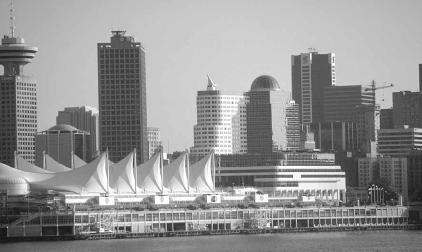
Imports are heavily concentrated in the industrial sector, including machinery, transport equipment, basic manufactures, and consumer goods. In 2002, international exports were at US $260.5 billion and imports US $229 billion. Therefore, Canada had a trade surplus of US $31.5 billion.
The United States is by far Canada's leading trade partner. Canada exchanges raw materials such as crude petroleum and processed items such as paper for United States machinery, transportation and communications equipment, and agricultural items, such as citrus fruits.
In 2000, the United States accounted for 86 percent of Canada's exports and 22 percent of imports. This made Canada the largest single-country export market for the US. In 1992, the United States, Canada, and Mexico signed the North American Free Trade Agreement (NAFTA), which was ratified by all three countries the following year.
Besides the United States, in 2000 Canada traded principally with European Union countries, Japan, the United Kingdom, and China.
28 PUBLIC FINANCE
By far the largest item of expenditure of the federal government is for social services, including universal pension plans, old age security, veterans benefits, unemployment insurance, family and youth allowances, and assistance to disabled, handicapped, unemployed, and other needy persons.
Sources of provincial revenue include various licenses, permits, fines, penalties, sales taxes, and royalties, augmented by federal subsidies, health grants, and other payments. Federal grants and surpluses and federal payments to the provinces under the federal-provincial tax-sharing arrangements constitute a major revenue source of the provinces. Corporation and personal income taxes provide a considerable portion of the revenue of Québec. The largest provincial expenditures are for highways, health and social welfare, education, natural resources, and primary industries. Real property taxes account for more than two-thirds of revenue for municipalities and other local authorities. Almost one-third of their expenditures goes to support local schools.
In 2000/01, Canada's central government took in revenues of US $178.6 billion. It had expenditures of US $161.4 billion. The government thus had a surplus of US $17.2 billion. External debt stood at US $1.9 billion.
29 TAXATION
The federal government levies direct and indirect taxes, of which the individual and corporation income taxes yield the largest return. Excise taxes (including a general sales tax), excise duties, and customs duties also produce a substantial revenue. Federal inheritance taxes were eliminated as of 1 January 1972. The federal goods and services tax (GST) went into effect on 1 January 1991. It is a 7 percent value-added tax on most goods and services.
Since 2000, the government has been engaged in a Five-Year Tax Reduction Plan. The plan aims to reduce the corporate tax rate to 21 percent, and the income tax rate to 23 percent by 2005.
30 HEALTH
Canada adopted a national health insurance scheme in 1971. It is administered regionally, with each province running a public insurance plan and the government contributing about 40 percent of the cost. Access to health care and cost containment are good, but there are strains on the budget, increased by the demands of an aging population.
Diseases of the heart and arteries account for more than 40 percent of all deaths, and cancer accounts for just under one-third; the proportion of deaths from causes related to old age is rising. Accidents are the leading cause of death in childhood and among young adult males, and rank high for other population groups. Life expectancy is estimated at 79 years.
31 HOUSING
There were slightly more than 10 million occupied private dwellings in Canada in the mid-1990s. Single homes are the most common type of dwelling, although their relative numbers have gradually fallen in favor of multiple dwellings. As of 2001, about 56.8 percent of dwellings were single detached homes; 30.5 percent were apartment buildings. There were an average of 6.1 rooms per dwelling and an average of 2.5 people per household.
32 EDUCATION
Practically the entire adult population is literate (96.6 percent). The age limits of compulsory school attendance are roughly from age 6 to age 16. Primary school lasts for six to eight years and secondary or high school another six years. In the late 1990s, primary schools numbered nearly 13,000 with about 150,000 teachers and 2.5 million students. Secondary schools had approximately 133,000 teachers and 2.5 million students.
Each province is responsible for its own system of education. While the systems differ in some details, the general plan is the same for all provinces except Québec, which has two parallel systems: one mainly for Roman Catholics and speakers of French, the other primarily for non-Catholics and speakers of English.
There are about 60 degree-granting colleges and universities in Canada. Full-time enrollment in all higher level institutions, colleges and universities is over two million.
Among the oldest Canadian institutions of higher education are the Collège des Jésuites in Québec City, founded in 1635; the Collège St. Boniface in Manitoba (1827); the University of Ottawa (1848); and St. Joseph's University in New Brunswick (1864). Most university-level instruction is conducted in English. Two private universities on the Scottish model are Dalhousie University in Halifax (1818) and McGill University in Montréal (1821). The first state-supported institution was King's College at York in Upper Canada, which became the University of Toronto, the largest and one of the most distinguished of Canadian institutions.
33 ARTS
The arts and crafts of the Dene Indians and the Inuit may be seen in cooperative workshops in Inuvik in the Northwest Territories; and of the North West Coast Indians, at the reconstructed Indian village of Ksan in British Columbia.
One of the world's foremost summer theatrical events is the Shakespeare Festival at Stratford, Ontario.
34 LIBRARIES AND MUSEUMS
Municipal public libraries serve the large cities and many small towns and rural areas, and regional units supply library service to scattered population areas. Traveling libraries, operated by provincial governments or university extension departments, also provide mail services for more isolated individuals and communities. In 2002, Canada had a total of 3,932 libraries.
There are about 2,000 museums, art galleries, and related institutions in Canada. The National Arts Center is located in Ottawa, as are Canada's four national museums: the National Gallery of Canada, the Canadian Museum of Civilization, the National Museum of Natural Sciences, and the National Museum of Science and Technology.
35 COMMUNICATIONS
The ten public and private companies in Telecom Canada provide a major share of the nation's telecommunications services, including all long-distance service, and link regional networks across Canada.
The publicly owned Canadian Broadcasting Corporation (CBC) provides the national broadcasting service in Canada. Privately owned local stations form part of the networks and provide alternative programs. As of 1999, there were 334 AM broadcasting stations, 35 FM stations, and 80 television stations. In 2000 there were 1,047 radios and 708 television sets per 1,000 people. Radio and television services reach 99 percent of Canadian homes. In 2001, there were about 760 Internet service providers serving 14.4 million subscribers.
36 PRESS
There are over 100 daily newspapers. Although some newspapers in Montréal, Québec, Toronto, Winnipeg, and Vancouver have more than local influence, most circulate only on a regional basis and have a limited number of readers. Rural areas are served by some 2,000 monthly and weekly publications. There are many consumer magazines, but only Maclean's is truly national.
Canada's leading newspapers (with their 2002 daily circulations) include the following: Toronto Star (459,900), Globe and Mail (353,950), The National Post (Toronto, 308,810), Le Journal de Montréal (262,660), Toronto Sun (230,620), the Vancouver Sun (187,790), and La Presse (182,660).
37 TOURISM, TRAVEL AND RECREATION
From the polar ice cap to the mountains, fjords, and rainforests of the west coast, Canada offers a remarkable range of scenic wonders. Among the most spectacular parks are the Kluane National Park in the Yukon Territory and the Banff (with Lake Louise) and Jasper national parks in the mountains of Alberta. Norse artifacts and reconstructed dwellings can be viewed at the excavation of L'Anse aux Meadows in Newfoundland.
Other attractions include Dinosaur Park in Alberta's Red Deer Badlands; the Cabot Trail in Nova Scotia; and the Laurentians and the Gaspé Peninsula in Québec. The arts and crafts of the Dene Indians and the Inuit may be seen in cooperative workshops in the Northwest Territories.
Québec City is the only walled city in North America. Montréal, the second-largest French-speaking city in the world (after Paris), is famous for its fine French cuisine, its vast underground shopping network, and its excellent subway system. Toronto is known for commerce, culture, modern architecture, and an outstanding zoo. One of the world's foremost summer theatrical events is the Shakespeare Festival at Stratford, Ontario.

In 1998, Canada was the third most popular tourist destination in the Americas after the US and Mexico. In that year, 18.8 million tourists arrived from abroad, with 14.8 percent of them from the United States and about 12 percent from Europe. In 2000, 19.6 million tourists arrived in Canada, with 15.2 million coming from the US.
38 SPORTS
Fishing and hunting attract many sportsmen to Canada, and ice hockey attracts many sports fans, particularly to the Forum in Montréal. Major league baseball teams play in Montréal and Toronto. In 1992, the Toronto major league baseball team, the Blue Jays, became the first non-American team to both play in and win the World Series. Toronto again won the World Series in 1993.
39 FAMOUS CANADIANS
Political Figures
Because of their exploits in establishing and developing early Canada, then known as New France, a number of eminent Frenchmen are prominent in Canadian history, among them the explorers Jacques Cartier (1491–1557), Samuel de Champlain (1567?–1635), and Jacques Marquette (1637–75). Later, Sir Wilfred Laurier (1841–1919) became the first French-Canadian prime minister. English-speaking Canadians of note include the first prime minister of the Dominion of Canada, Sir John A. MacDonald (1815–91), and William Lyon Mackenzie King (1874–1950).
Artists
Highly regarded Canadian painters include James Edward Hervey MacDonald (1873–1932), Frederick Horsman Varley (1881–1969), and Emily Carr (1871–1945). Two other artists of distinction were James W. G. MacDonald (1897–1960) and Harold Barling Town (1924–91). The portrait photographer Yousuf Karsh (1908–2002), who was born in Turkish Armenia, was a long-time Canadian resident.
Musicians
Well-known Canadian musicians include the pianist Glenn Gould (1932–82); the singers Jon Vickers (b.1926) and Maureen Forrester (b.1931); the bandleader Guy Lombardo (1902–77); and, among recent popular singers and songwriters, Gordon Lightfoot (b.1938), Joni Mitchell (b.1943), Neil Young (b.1945), and Celine Dion (b.1968).
Actors
Canadian-born actors who are known for their association with Hollywood include Mary Pickford (Gladys Mary Smith, 1893–1979), Walter Huston (Houghston, 1884–1950), Lorne Greene (1915–87), Raymond Burr (1917–94), William Shatner (b.1931), Donald Sutherland (b.1935), and Jim Carrey (b.1962).
Sports
Notable in the world of sports are ice-hockey stars Maurice ("Rocket") Richard (1921–2000), Gordon ("Gordie") Howe (b.1928), Robert Marvin ("Bobby") Hull, Jr. (b.1939), Robert ("Bobby") Orr (b.1948), and Wayne Gretzky (b.1961).
Authors
The Anne of Green Gables novels of Lucy Maud Montgomery (1874–1942) have been popular with readers of several generations. Louis Hémon (1880–1913), a French journalist who came to Canada in 1910 and spent only 18 months there, wrote the classic French Canadian novel Maria Chapdelaine (1914).

Scientists and Inventors
Among the famous Canadian scientists and inventors are Sir Sanford Fleming (1827–1915), inventor of standard time, and Sir William Osler (1849–1919), the father of psychosomatic medicine. The codiscoverers of insulin, Sir Frederick Grant Banting (1891–1941) and John James Richard Macleod (1876–1935), were awarded the Nobel Prize for medicine in 1923.
40 BIBLIOGRAPHY
Barlas, Robert. Welcome to Canada. Milwaukee: Gareth Stevens, 1999.
Dahl, Michael. Canada. Mankato, MN: Bridgestone, 1998.
Grabowski, John F. Canada. San Diego: Lucent, 1998.
Greenwood, Barbara. The Kids Book of Canada. Buffalo, NY: Kids Can Press, 1998.
Hamilton, Janice. Canada. Minneapolis: Carolrhoda Books, 1999.
Kalman, Bobbie. Canada. New York: Crabtree, 2002.
Law, Kevin. Canada. New York: Chelsea House, 1999.
Lee, Douglas B. "Montreal—Heart of French Canada." National Geographic, March 1991, 60–85.
Malcolm, A. H. The Canadians. New York: Times Books, 1985.
Marshall, David. Canada. New York: Thomson Learning, 1996.
Moore, Christopher. The Big Book of Canada. Plattsburgh, NY: Tundra Books of Northern New York, 2002.
Murphy, Patricia J. Canada Day. New York: Children's Press, 2002.
Turnbull, Andy. By Truck to the North: My Arctic Adventure. Toronto: Annick Press, 1998.
Web sites
Canada Tourism Commission. http://www.canadatourism.com/ctx/app (accessed on March 24, 2004).
Government of CanadaSite. http://canada.gc.ca/main_e.html (accessed on March 24, 2004).
Statistics Canada. http://www.statcan.ca (accessed on March 24, 2004).
Comment about this article, ask questions, or add new information about this topic: